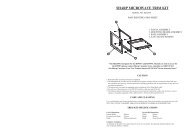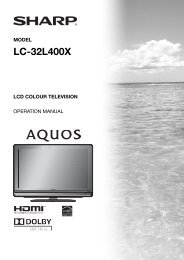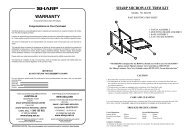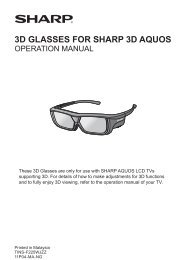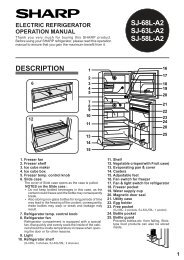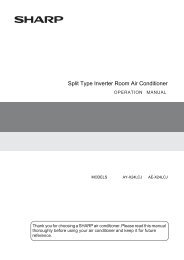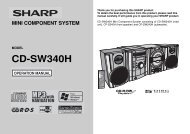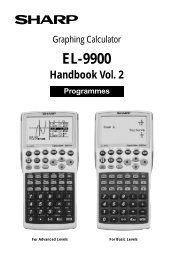washing machine user's manual es-v80ha - Sharp Australia Support
washing machine user's manual es-v80ha - Sharp Australia Support
washing machine user's manual es-v80ha - Sharp Australia Support
You also want an ePaper? Increase the reach of your titles
YUMPU automatically turns print PDFs into web optimized ePapers that Google loves.
WASHING MACHINE<br />
USER’S MANUAL<br />
ES-V80HA<br />
BEFORE USING THE WASHING MACHINE, PLEASE READ THE<br />
INFORMATION IN THIS MANUAL.
CONTENTS<br />
CHAPTER-1: TECHNICAL SPECIFICATIONS 3<br />
CHAPTER-2: BEFORE USING WASHING MACHINE 5<br />
Safety warnings 5<br />
Recommendations 6<br />
CHAPTER-3: SETTING UP ..... 7<br />
Removing transport safety screws 7<br />
Adjusting adjustable stays 9<br />
Electrical connection 10<br />
Water inlet connection 10<br />
Water discharge connection 11<br />
CHAPTER-4: PRELIMINARY PREPARATION FOR<br />
WASHING 12<br />
CHAPTER-5: CONTROL PANEL 15<br />
Detergent drawer 16<br />
Programme knob 17<br />
Electronic display 18<br />
CHAPTER-6: OPERATING YOUR MACHINE 19<br />
Selecting programme 19<br />
Auxiliary functions 19<br />
Starting the programme 28<br />
Adding/Removing laundry 29<br />
Child lock 30<br />
Cancelling programme 31<br />
Finishing programme 32<br />
CHAPTER-7: ELECTRONIC DISPLAY WARNING SYMBOLS 33<br />
Warning of water cut-off/low mains water pr<strong>es</strong>sure 33<br />
Warning of clogged pump fitler 34<br />
CHAPTER-8: MAINTENANCE AND CLEANING OF YOUR<br />
MACHINE 35<br />
CHAPTER-9: PRACTICAL INFORMATION 40<br />
CHAPTER-10: TROUBLESHOOTING 42<br />
CHAPTER-11: AUTOMATIC FAULT WARNINGS AND<br />
WHAT TO BE DONE 47<br />
CHAPTER-12: SAVING ENERGY AND WATER 49<br />
2
CHAPTER -1: TECHNICAL SPECIFICATIONS<br />
1<br />
2 3 4<br />
1.Detergent drawer<br />
2. Upper tray<br />
3.Programme knob<br />
4.Electronic display<br />
5.Door<br />
6.Pump filter cover<br />
5<br />
8 9<br />
6<br />
10<br />
7 7<br />
7 7<br />
7. Transport safety<br />
screws<br />
8.Power cable<br />
9. Discharging hose<br />
10.Water inlet valve<br />
3
CHAPTER -1: TECHNICAL SPECIFICATIONS<br />
Operating voltage / frequency (V/Hz)<br />
Total current (A)<br />
Water pr<strong>es</strong>sure (MPa)<br />
Total power (W)<br />
Maximum dry laundry capacity (kg)<br />
Maximum spin speed (rev / min)<br />
Number of <strong>washing</strong> programm<strong>es</strong><br />
Dimensions<br />
(Height x Width x Depth) (mm)<br />
(220-240) V ~/50Hz<br />
10<br />
Maximum: 1 MPa<br />
Minimum: 0.1 MPa<br />
2200<br />
8<br />
1400<br />
15<br />
845 x 597 x 587<br />
4
CHAPTER -2: BEFORE USING YOUR WASHING MACHINE<br />
SAFETY WARNINGS<br />
SAFETY WARNINGS<br />
Do not use double adaptors, power boards or extension cords.<br />
Do not use if the power cord or plug is damaged.<br />
<br />
<br />
Never pull the cable when unplugging.<br />
Do not plug-in or pull out the plug from the receptacle with wet<br />
hands to prevent electric shock. Never touch the <strong>machine</strong> when<br />
wet.<br />
Never open the detergent compartment when the appliance is<br />
running.<br />
Never force the door open when the <strong>washing</strong> <strong>machine</strong> is running.<br />
Do not touch discharging hose and water during discharging as the<br />
appliance may reach high temperatur<strong>es</strong> when running.<br />
In case of breakdown, unplug the appliance first and then turn the<br />
water off. Do not attempt to repair by yourself, consult authorized<br />
service.<br />
Remember that packaging materials may be dangerous for<br />
children. Keep the packaging materials away from children or<br />
dispose of them.<br />
Do not allow your children play with the <strong>washing</strong> <strong>machine</strong> which is<br />
an electrically-driven appliance.<br />
Keep your pets away from your <strong>machine</strong>.<br />
Your <strong>machine</strong> should only be used by adults in line with the<br />
information provided in this user’s <strong>manual</strong>.<br />
Your <strong>machine</strong> is d<strong>es</strong>igned to be used dom<strong>es</strong>tically.<br />
Do not place your <strong>machine</strong> on carpet and suchlike grounds that<br />
could block ventilation of the base.<br />
Do not keep inflammable liquids near your <strong>machine</strong>.<br />
5
CHAPTER -2: BEFORE USING YOUR WASHING MACHINE<br />
SAFETY WARNINGS / RECOMMENDATIONS<br />
You must remove the transport screws of your <strong>machine</strong> before the<br />
first usage. Faults occurring in a <strong>machine</strong> operated with the<br />
transport screw fitted shall be out of scope of warranty.<br />
Do not put discharging hose of your <strong>machine</strong> in a v<strong>es</strong>sel or bucket.<br />
This appliance is not intended for use by persons (including<br />
children) with reduced physical, sensory or mental capabiliti<strong>es</strong>, or<br />
lack of expererience and knowledge. Unl<strong>es</strong>s they have been given<br />
supervision or instruction concerning the use of this appliance by a<br />
person r<strong>es</strong>ponsible for their safety.<br />
Keep pets away from the <strong>washing</strong> <strong>machine</strong>.<br />
RECOMMENDATIONS<br />
It is recommended to perform the first <strong>washing</strong> operation in<br />
95 White Cotton programme and without laundry by inserting<br />
½ measure of detergent in 2 nd compartment of the detergent<br />
drawer.<br />
As detergent or softener exposed to air for a long time may cause<br />
r<strong>es</strong>idu<strong>es</strong>, put your detergent or softener in the detergent drawer in<br />
the beginning of each <strong>washing</strong>.<br />
It is recommended that you wash only extremely dirty laundry in<br />
pre<strong>washing</strong> programme.<br />
The amount of laundri<strong>es</strong> you put in your <strong>washing</strong> <strong>machine</strong> should<br />
not exceed the maximum amount indicated. By this way, your<br />
<strong>machine</strong> shall run the most efficiently.<br />
Some water may be left in your <strong>machine</strong> due to quality control<br />
t<strong>es</strong>ts carried out during production. This will not damage your<br />
<strong>machine</strong>.<br />
After completing your <strong>washing</strong> for the day, it will help to keep the<br />
<strong>machine</strong> smelling fr<strong>es</strong>h if you leave the door slightly open to allow<br />
the flow of fr<strong>es</strong>h air.<br />
6
CHAPTER -3: SETTING UP<br />
REMOVING TRANSPORT SAFETY SCREWS<br />
Before operating your <strong>washing</strong> <strong>machine</strong>, you must remove the<br />
transport safety screw on the rear side of the <strong>machine</strong>.<br />
For this reason, transport safety screws shall be loosened by being<br />
rotated in counter-clockwise using an appropriate spanner.<br />
7
CHAPTER -3: SETTING UP<br />
REMOVING TRANSPORT SAFETY SCREWS<br />
Transport screws shall be removed by pulling out.<br />
Fit the plastic transport screw taps delivered in acc<strong>es</strong>sori<strong>es</strong> bag to the<br />
plac<strong>es</strong> where transport screws have been removed.<br />
The transport safety screws should be stored to be used in case of a<br />
transportation.<br />
Do not operate the <strong>machine</strong> with the transport screws fitted. Damage<br />
to the <strong>machine</strong> is likely to occur.<br />
8
CHAPTER -3: SETTING UP<br />
ADJUSTING ADJUSTABLE STAYS<br />
Do not install your <strong>machine</strong> on a carpet or suchlike grounds.<br />
To ensure silent and vibration-free operation of your <strong>machine</strong>, it<br />
should be placed on a non-sliding and firm ground.<br />
Loosen the plastic locking nut.<br />
Adjust the feet upward and downward by rotating them.<br />
Never put cardboard, wood or suchlike materials under your<br />
<strong>machine</strong> if you are intending to stabilize the distortions on the<br />
ground.<br />
When cleaning the ground, on which your <strong>machine</strong> r<strong>es</strong>ts, be<br />
careful not to disorder stays stabilization.<br />
Adjust the feet, so that the <strong>machine</strong> is level and all feet are<br />
touching the floor amd the <strong>machine</strong> do<strong>es</strong> not rock. Then adjust up<br />
the “locking nut”<br />
9
CHAPTER -3: SETTING UP<br />
ELECTRICAL CONNECTION / WATER INLET CONNECTION<br />
Electrical connection<br />
Your <strong>washing</strong> <strong>machine</strong> is set to 220-240V and 50Hz.<br />
Water inlet connection<br />
Your <strong>machine</strong> may have either a single inlet (cold) or double water<br />
inlets (cold/hot) based on its specifications. White-capped hose<br />
should be connected to cold water inlet and red-capped hose to<br />
hot water inlet (applicable for <strong>machine</strong>s with double water inlets).<br />
To eliminate water leakag<strong>es</strong> in points of contact, 1 or 2 washers<br />
are provided in the hose package (applicable for <strong>machine</strong>s with<br />
double water inlets). Fit th<strong>es</strong>e washers to the ends of new water<br />
inlet hos<strong>es</strong> on the side of the tap.<br />
Connect the white-elbow end of the water inlet hos<strong>es</strong> to the whitefiltered<br />
water inlet valve on the rear side of the <strong>machine</strong> and the<br />
red-elbow end to red-filtered one (applicable for <strong>machine</strong>s with<br />
double water inlets). Tighten plastic parts of the junctions using<br />
your hand.<br />
Flow of water with pr<strong>es</strong>sure of 0.1-1 Mpa will allow your <strong>machine</strong> to<br />
operate more efficiently (0.1 Mpa pr<strong>es</strong>sure means that more than 8<br />
litr<strong>es</strong> of water will flow through a fully-opened tap per one minute).<br />
Ensure that new water inlet hos<strong>es</strong> are not folded, broken, crushed<br />
or their dimensions are not altered.<br />
Connect new water inlet hos<strong>es</strong> to a ¾ , threaded tap.<br />
If your <strong>machine</strong> has double hot water inlets, the temperature of hot<br />
water inlet should not exceed 70°C.<br />
10
CHAPTER -3: SETTING UP<br />
WATER INLET CONNECTION / WATER DSCHARGE<br />
CONNECTION<br />
Water discharge connection<br />
Ensure that water discharge hose is not folded, twisted, crushed or<br />
elongated.<br />
Water discharge hose can be fitted minimum 60 cm and maximum<br />
100 cm above the ground.<br />
<br />
The end of water discharge hose can be attached to dirty water<br />
discharge hole or outlet joint of the basin elbow.<br />
Never attempt to extend the water discharge hose by jointing.<br />
Do not put discharging hose of your <strong>machine</strong> in a v<strong>es</strong>sel or,<br />
bucket.<br />
11
CHAPTER-4: PRELIMINARY PREPARATION FOR WASHING<br />
Separate your laundri<strong>es</strong> according to their typ<strong>es</strong> (cotton, synthetic,<br />
sensitive, woollen, etc.), their temperatur<strong>es</strong> (cold, 30°, 40°, 60°,<br />
90°) and degree of contamination (slightly stained, stained, highly<br />
stained).<br />
Never wash your coloured and white laundri<strong>es</strong> together.<br />
Wash your coloured laundri<strong>es</strong> separately in the first <strong>washing</strong> as<br />
they may colour bleed.<br />
<br />
Ensure that there are no metallic materials on your laundri<strong>es</strong> or in<br />
the pockets; if so, take them out.<br />
WARNING: Faults that will emerge in case of penetration of<br />
foreign substanc<strong>es</strong> into your <strong>machine</strong> are not included within the<br />
scope of warranty.<br />
Remove the metallic or plastic hooks of tulle curtains or curtains or<br />
place them in a <strong>washing</strong> net or bag and then muzzle them.<br />
Zip-up and button up your laundri<strong>es</strong>.<br />
Turn inside out pants, knitwear, t-shirt and sweat suit.<br />
Normal <strong>washing</strong><br />
Maximum<br />
<strong>washing</strong><br />
temperature is<br />
90°C<br />
Maximum<br />
<strong>washing</strong><br />
temperature is<br />
60°C<br />
Maximum<br />
<strong>washing</strong><br />
temperature is<br />
30 °C<br />
Hand <strong>washing</strong><br />
No <strong>washing</strong><br />
12
CHAPTER-4: PRELIMINARY PREPARATION FOR WASHING<br />
Open the door of your <strong>machine</strong>.<br />
Spread your laundri<strong>es</strong> in your <strong>machine</strong>.<br />
Note: Maximum loading capacity may vary based on the<br />
laundry type you will wash, degree of contamination and the<br />
programme you have chosen. Do not exceed maximum dry<br />
loading capacity indicated in the programme table for<br />
<strong>washing</strong> programm<strong>es</strong>.<br />
You can take the following table of weights as an example.<br />
LAUNDRY TYPE<br />
WEIGHT (gr)<br />
Towel 200<br />
Linen 500<br />
Bathrobe 1200<br />
Quilt cover 700<br />
Pillow slip 200<br />
Underwear 100<br />
Tablecloth 250<br />
Put the laundri<strong>es</strong> separately.<br />
Ensure that no laundry is stuck between the cover and bellow seal<br />
when closing the door of your <strong>machine</strong>.<br />
Close the door of your <strong>machine</strong> properly; otherwise your <strong>machine</strong><br />
will not start the <strong>washing</strong> operation.<br />
13
CHAPTER-4: PRELIMINARY PREPARATION FOR WASHING<br />
The amount of detergent you will put in your <strong>machine</strong> will depend on<br />
the following criteria:<br />
Your detergent requirement will be based on the degree of<br />
contamination of your laundri<strong>es</strong>. Do not prewash your l<strong>es</strong>s stained<br />
laundri<strong>es</strong> and put your slight amount of detergent in the 2 nd<br />
compartment of the detergent drawer.<br />
For your much stained laundri<strong>es</strong>, select a programme including<br />
pre<strong>washing</strong>, and put ¼ of the detergent you will put in the<br />
detergent drawer in the 1 st compartment of the detergent drawer<br />
while putting the remaining ¾ of it into 2 nd compartment.<br />
Use detergents produced for front loading <strong>machine</strong>s. The amount<br />
of detergent you will use for your laundri<strong>es</strong> is printed on the<br />
detergent package.<br />
The higher the degree of hardn<strong>es</strong>s of the water the more detergent<br />
you will use.<br />
The amount of the detergent you will use will increase as the<br />
amount of your laundri<strong>es</strong> increase.<br />
Put the softener in the softener compartment in the detergent<br />
drawer. Do not exceed the MAX level. Otherwise, softener will flow<br />
into <strong>washing</strong> water through flushing and stain your laundry.<br />
Softeners with high density are required to be thinned to a degree<br />
before being put in the drawer. Because high-density softener will<br />
clog the flush and avoid the flow of the softener.<br />
You can use your liquid detergents in all programs without<br />
pre<strong>washing</strong>. For this, fit liquid detergent level plate in the<br />
acc<strong>es</strong>sori<strong>es</strong> bag into 2 nd compartment of the detergent drawer and<br />
set the amount of liquid detergent according to the levels on this<br />
plate. Remember to detach the liquid detergent plate.<br />
14
CHAPTER 5: CONTROL PANEL<br />
1 2 3<br />
1-Detergent drawer<br />
2-Programme knob<br />
3-Electronic display and auxiliary functions<br />
15
CHAPTER 5: CONTROL PANEL<br />
DETERGENT DRAWER<br />
E<br />
B<br />
D<br />
A<br />
C<br />
A. Pre<strong>washing</strong> compartment<br />
B. Main <strong>washing</strong> compartment<br />
C. Softener compartment<br />
D. Siphon cover<br />
E. Liquid level detergent plate<br />
16
CHAPTER 5: CONTROL PANEL<br />
PROGRAMME KNOB<br />
Select the programme you wish to wash your laundri<strong>es</strong> through<br />
programme knob. You may set the programme selection<br />
operation by rotating the programme knob in both direction.<br />
Ensure that the programme knob is exactly on the programme<br />
you want to select.<br />
17
CHAPTER 5: CONTROL PANEL<br />
ELECTRONIC DISPLAY<br />
1-Adjusting button for revolution speed<br />
2-Adjusting button for temperature of <strong>washing</strong> water<br />
3-Auxiliary function prewash<br />
4-Auxiliary function for rapid wash<br />
5-Auxiliary function for easy ironing<br />
6-Auxiliary function for delay timer<br />
7-Start/Pause button<br />
8-Electronic display<br />
On the electronic display, you may view <strong>washing</strong> water temperature,<br />
spin speed of your <strong>machine</strong>, the amount time your <strong>machine</strong> will<br />
continue <strong>washing</strong>, the auxiliary functions you have selected and<br />
whether the door of your <strong>machine</strong> is locked or not. Furthermore,<br />
electronic display will warn you by means of fault symbols on the<br />
display when a fault occurs on your <strong>machine</strong> and notify you of the<br />
completion of the <strong>washing</strong> programme by revealing expr<strong>es</strong>sion of<br />
“END” on the display as soon as the <strong>washing</strong> programme you have<br />
selected has finished as well.<br />
18
CHAPTER 6: OPERATING YOUR MACHINE<br />
Plug your <strong>machine</strong> in.<br />
Turn on the tap.<br />
Open the <strong>machine</strong> door.<br />
Load your laundri<strong>es</strong> in your <strong>machine</strong>.<br />
Push the door of your <strong>machine</strong> until hearing the locking sound to<br />
close it.<br />
Put detergent and softener in the detergent drawer.<br />
First <strong>washing</strong> operation<br />
Some water may be left in your <strong>machine</strong> due to quality control t<strong>es</strong>t<br />
carried out during production. To dispose of this water, it is<br />
recommended to perform the first <strong>washing</strong> operation in 1 st programme<br />
and without laundry by inserting ½ scale of detergent in 2 nd<br />
compartment of the detergent drawer.<br />
Selecting programme<br />
Select the convenient programme for your laundri<strong>es</strong> on the<br />
programme table.<br />
Auxiliary functions<br />
Before starting the programme, you can optionally select an auxiliary<br />
function.<br />
Pr<strong>es</strong>s on the button of auxiliary function you like to select.<br />
If auxiliary function symbol on electronic display flash<strong>es</strong><br />
continuously, the auxiliary function you have selected will be<br />
activated.<br />
If auxiliary function symbol on electronic display blinks, the<br />
auxiliary function you have selected will not be activated.<br />
Reason for non-activation:<br />
-The auxiliary function you want to use in the <strong>washing</strong> programme you<br />
have selected is not applicable.<br />
-Your <strong>machine</strong> has passed over the stage, during which the auxiliary<br />
function you like to select would be implemented.<br />
-It is not compatible with an auxiliary function you have selected<br />
previously.<br />
19
CHAPTER 6: OPERATING YOUR MACHINE<br />
Half-load detection system<br />
Your <strong>machine</strong> featur<strong>es</strong> a half-load detection system. In case you put<br />
approximately half or l<strong>es</strong>s amount of laundri<strong>es</strong> of maximum laundry<br />
capacity in your <strong>machine</strong>, your <strong>machine</strong> will run so as to save <strong>washing</strong><br />
time, water consumption and energy in some programm<strong>es</strong> (White<br />
cotton 95°, Colorfast cotton 60°, Non colorfast cotton 40°). When halfload<br />
function is active, the <strong>machine</strong> can complete the programme you<br />
have set in a shorter time.<br />
Twinjet system<br />
Detergent water in your <strong>machine</strong> will be circulated with 2 water<br />
injection mechanisms and a mixing system via twinjet system.<br />
Circulated detergent water will be injected over your laundry, which<br />
allows a better <strong>washing</strong> performance.<br />
Twinjet system will help you wash higher amount of laundry in a<br />
shorter time with a better <strong>washing</strong> performance, l<strong>es</strong>s energy and water<br />
consumption.<br />
20
CHAPTER 6: OPERATING YOUR MACHINE<br />
PROGRAM TABLE<br />
PROGRAMME<br />
TEMPERATURE<br />
(°C)<br />
MAXIMUM<br />
AMOUNT OF<br />
DRY<br />
LAUNDRY<br />
(kg)<br />
DETERGENT<br />
COMPARTMENT<br />
1-COTTON 95 8 2<br />
2-COTTON 60 8 2<br />
3-COTTON 40 8 2<br />
LAUNDRY TYPE<br />
Very dirty cotton and flax textil<strong>es</strong>. (Underwears, linen, tablecloth, (towel maximum 4 kg),<br />
bedcloth<strong>es</strong>, etc.)<br />
Dirty cotton and flax textil<strong>es</strong>. (Underwears, linen, tablecloth, (towel maximum 4 kg),<br />
bedcloth<strong>es</strong>, etc.)<br />
Normally soiled cotton cloth<strong>es</strong> (Underwears, linen, tablecloth, (towel maximum 4 kg),<br />
bedcloth<strong>es</strong>, etc.)<br />
4-SYNTHETICS 60 3,5 2<br />
Very dirty synthetic or synthetic-mixed textil<strong>es</strong>. (Nylon socks, shirts, blous<strong>es</strong>, syntheticincluding<br />
trousers etc.)<br />
5-SILK 30 2,5 2 L<strong>es</strong>s dirty silk-mixed laundri<strong>es</strong> with <strong>machine</strong> wash labels.<br />
6-WOOL 40 2,5 2 Woollen laundri<strong>es</strong> with <strong>machine</strong> wash labels.<br />
7-RINSE - 8 -<br />
If you want to additionally rinse your laundri<strong>es</strong> upon completion of <strong>washing</strong> operation,<br />
you may use this programme for any kind of laundri<strong>es</strong>.<br />
8-SPIN - 8 -<br />
If you want to additionally wring your laundri<strong>es</strong> upon completion of <strong>washing</strong> operation,<br />
you may use this programme for any kind of laundri<strong>es</strong>.<br />
9-HAND WASH 30 2,5 2<br />
Sensitive and woollen laundri<strong>es</strong> with non-<strong>machine</strong> wash label recommended to be<br />
washed by hand.<br />
10-SPORTS WEAR 30 3,5 2 Sportswear.<br />
11-MIX WASH 30 3,5 2 Dirty cotton, synthetic, colour and flax textil<strong>es</strong> can be washed together.<br />
12-SHIRTS/<br />
BLOUSES<br />
60 4 2 Dirty cotton, synthetic and synthetic-mixed shirts and blous<strong>es</strong> can be washed together.<br />
13-HYGIENE 30 5 2<br />
For European Countri<strong>es</strong> only. This function requir<strong>es</strong> <strong>washing</strong> detergents that meet<br />
European IEC Standards.<br />
14-DAILY 60 min. 60 4 2 You can wash your dirty cotton, colour and flax textil<strong>es</strong> at 60°C in 60 minut<strong>es</strong>.<br />
15-SUPER RAPID<br />
12 min.<br />
30 2 2<br />
You can wash your slightly dirty cotton, colour and flax textil<strong>es</strong> in 12 minut<strong>es</strong> that is a<br />
short period.<br />
Note: As the <strong>washing</strong> period is short, l<strong>es</strong>s amount of detergent is required to be used<br />
compared to other programm<strong>es</strong>. The programme period will increase if your <strong>machine</strong><br />
detects an unstable load. You can open the door of your <strong>machine</strong> 2 minut<strong>es</strong> after the<br />
completion of <strong>washing</strong> operation. (The duration of 2 minut<strong>es</strong> required to open the door<br />
of your <strong>machine</strong> is not included in the <strong>washing</strong> period.)<br />
Program duration, energy consumption and water consumption valu<strong>es</strong> may vary according to wash load weight and type, selected extra functions, tap water and ambient<br />
temperature<br />
21
CHAPTER 6: OPERATING YOUR MACHINE<br />
AUXILIARY FUNCTIONS<br />
1-Spin speed selection and auxiliary function of soaking<br />
You can set the spin speed for your laundry via spin speed setting<br />
button.<br />
When you select a new<br />
programme, the maximum spin<br />
speed of the programme you have<br />
selected will be viewed on the<br />
display of spin speed.<br />
You can gradually reduce the spin<br />
speed between cancel spinning (--<br />
) options through the maximum<br />
spinning speed of the programme<br />
selected by pr<strong>es</strong>sing spin speed<br />
setting button.<br />
If you have skipped the spin speed you want to set, you can re-switch<br />
to the speed by keeping the spin speed setting button pr<strong>es</strong>sed.<br />
If you do not remove your laundri<strong>es</strong> upon completion of the<br />
programme and you do not want them to wrinkle in your <strong>machine</strong>, you<br />
can use the auxiliary function of soaking.<br />
In programm<strong>es</strong> where auxiliary<br />
function of soaking is an option, it<br />
may be activated by pr<strong>es</strong>sing the<br />
spin speed setting button once<br />
more. You can see that it is active<br />
when symbol flash<strong>es</strong> on<br />
electronic display.<br />
22
CHAPTER 6: OPERATING YOUR MACHINE<br />
AUXILIARY FUNCTIONS<br />
If this function is selected, your laundri<strong>es</strong> will be soaked in the lat<strong>es</strong>t<br />
rinsing water. When your <strong>machine</strong> soaks your laundri<strong>es</strong> in the lat<strong>es</strong>t<br />
rinsing water, symbol will blink on electronic display.<br />
If you want to take your laundri<strong>es</strong> out, pr<strong>es</strong>s on “Start / Pause” button.<br />
Your <strong>machine</strong> will empty the water in it and finish the programme<br />
without spinning.<br />
If you want to spin your laundri<strong>es</strong> again:<br />
a) You can select spin speed by using the spin speed setting<br />
button when your <strong>machine</strong> is soaking your laundri<strong>es</strong> in the<br />
lat<strong>es</strong>t rinsing water. If you want to take your laundri<strong>es</strong> out,<br />
pr<strong>es</strong>s on “Start / Pause” button. Your <strong>machine</strong> will empty the<br />
water in it and finish the programme after spinning your<br />
laundri<strong>es</strong> through the spinning speed you have selected.<br />
b) Switch the programme knob to 0. Select spin programme on<br />
programme knob. You can optionally reduce the spin speed.<br />
You can start your <strong>machine</strong> by pr<strong>es</strong>sing on Start/Pause button.<br />
Your <strong>machine</strong> will finish the programme after spinning your<br />
laundri<strong>es</strong> in the spinning speed you have selected.<br />
23
CHAPTER 6: OPERATING YOUR MACHINE<br />
AUXILIARY FUNCTIONS<br />
2-Washing water temperature selection<br />
You can select the <strong>washing</strong> water temperature with the <strong>washing</strong> water<br />
temperature adjustment button.<br />
Whenever you select a new<br />
programme, the maximum<br />
<strong>washing</strong> water temperature is<br />
shown on the <strong>washing</strong> water<br />
temperature display.<br />
You can gradually decrease the<br />
<strong>washing</strong> water temperature<br />
between the maximum<br />
temperature and cold <strong>washing</strong> (--)<br />
by pr<strong>es</strong>sing <strong>washing</strong> water<br />
temperature adjustment button.<br />
If you have missed the <strong>washing</strong> water temperature setting you wanted,<br />
you can return to the intended temperature by continuously pr<strong>es</strong>sing<br />
the <strong>washing</strong> water temperature adjustment button.<br />
24
CHAPTER 6: OPERATING YOUR MACHINE<br />
AUXILIARY FUNCTIONS<br />
3-Auxiliary function prewash<br />
Very dirty laundry can be prewashed<br />
before the main wash<br />
with this function. When using this<br />
function, you should put detergent<br />
in front <strong>washing</strong> compartment of<br />
the detergent drawer.<br />
4-Auxiliary function for rapid wash<br />
This auxiliary function will enable<br />
the <strong>washing</strong> duration of your<br />
laundri<strong>es</strong> that are not very dirty to<br />
be shortened. In case you put<br />
half of or l<strong>es</strong>s than half of the<br />
laundry capacity of the <strong>washing</strong><br />
programme you have selected in<br />
your <strong>machine</strong>, your <strong>machine</strong> will<br />
detect this event thanks to<br />
automatic half-load detection<br />
system, and the programme you have selected will wash your<br />
laundri<strong>es</strong> in a shorter time to consume l<strong>es</strong>s energy and water. If your<br />
<strong>machine</strong> detects half load, symbol will automatically flash on<br />
electronic display. To cancel it, pr<strong>es</strong>sing on the auxiliary function of<br />
quick <strong>washing</strong> for once will be enough. However, selection of auxiliary<br />
function of quick <strong>washing</strong> is not possible in course of the same<br />
<strong>washing</strong> operation.<br />
5-Auxiliary function for easy ironing<br />
You can enable your laundri<strong>es</strong> to<br />
be taken out l<strong>es</strong>s wrinkled as the<br />
<strong>washing</strong> operation is completed<br />
by employing this auxiliary<br />
function.<br />
25
CHAPTER 6: OPERATING YOUR MACHINE<br />
AUXILIARY FUNCTIONS<br />
6-Auxiliary function for delay timer<br />
By using this auxiliary function,<br />
you can let your <strong>machine</strong> start<br />
<strong>washing</strong> after half an hour to 23<br />
hours. For time of use electricity<br />
customer, this allows you to use<br />
your electricity at a cheaper tariff<br />
rate.<br />
To use auxiliary function of delay timer:<br />
- Pr<strong>es</strong>s time delay button once.<br />
- Expr<strong>es</strong>sion of “0.5h” will appear on the display.<br />
- Pr<strong>es</strong>s on time delay button until the time, on which you want <strong>washing</strong><br />
operation to be started.<br />
- To activate the time delay you have selected in the programme, you<br />
may pr<strong>es</strong>s on any auxiliary function button you like except<br />
“Start/Pause” button.<br />
Intervals of delay timer is half an hour for the first 2 hours, 1 hour for 3<br />
hours to 23 hours.<br />
If you have skipped the time delay you want to set, you can go back to<br />
the time d<strong>es</strong>ired by keeping pr<strong>es</strong>sed on delay timer button.<br />
If you want to cancel the delay timer, you are required to pr<strong>es</strong>s the<br />
delay timer button once.<br />
To run delay timer function, your <strong>machine</strong> is required to be operated<br />
by pr<strong>es</strong>sing on Start/Pause button. As soon as you start your <strong>machine</strong>,<br />
the count down proc<strong>es</strong>s will start on the electronic display based on<br />
the delay period you have selected.<br />
26
CHAPTER 6: OPERATING YOUR MACHINE<br />
AUXILIARY FUNCTIONS<br />
7-Anti-Allergic auxiliary function<br />
In the programm<strong>es</strong> where this<br />
auxiliary function is active, your<br />
<strong>machine</strong> will perform an extra<br />
rinsing operation on your<br />
laundri<strong>es</strong> prior to lat<strong>es</strong>t rinsing<br />
operation.<br />
Note: Anti-Allergic auxiliary function is selected automatically only in<br />
Hygiene programme.<br />
27
CHAPTER 6: OPERATING YOUR MACHINE<br />
STARTING THE PROGRAMME<br />
Start/Pause button<br />
By pr<strong>es</strong>sing on Start/Pause<br />
button, you may start the<br />
programme you have selected or<br />
suspend a running programme. If<br />
you switch your <strong>machine</strong> to pause<br />
mode, the electronic display will<br />
blink.<br />
When you start your <strong>machine</strong>, the following symbols for the<br />
programm<strong>es</strong> you have selected will be available on electronic display.<br />
- Temperature of <strong>washing</strong> water<br />
- Spin Speed<br />
- If you have selected, symbols of auxiliary functions<br />
- Programme ending time or programme delay time based on your<br />
selection<br />
- Symbol of open or locked door<br />
Note: Symbol for open door flashing on electronic display will go off<br />
and symbol for locked door will flash approximately 1 minute after you<br />
start your <strong>machine</strong> by pr<strong>es</strong>sing Start/pause button.<br />
Open door<br />
Locked door<br />
28
CHAPTER 6: OPERATING YOUR MACHINE<br />
ADDING/REMOVING LAUNDRY<br />
Laundry adding to / removing from the <strong>machine</strong><br />
If you want to add or remove laundri<strong>es</strong> when your <strong>machine</strong> is running:<br />
- Switch your <strong>machine</strong> to pause mode by pr<strong>es</strong>sing on Start/Pause<br />
button.<br />
- After a while, if you see that the symbol has changed on the<br />
display, this means that the door of your <strong>machine</strong> can now be opened.<br />
When you see symbol on electronic display, you can either add or<br />
remove laundri<strong>es</strong> after opening the <strong>machine</strong> door.<br />
Note: If symbol blinks on the electronic display, it means that your<br />
<strong>machine</strong> cannot carry out the operation of laundry adding or removing<br />
as your <strong>machine</strong> has passed the steps in qu<strong>es</strong>tion.<br />
- Upon completion of laundry adding or removing function, close the<br />
door of your <strong>machine</strong> and pr<strong>es</strong>s on Start/Pause button.<br />
- Your <strong>machine</strong> will continue to wash after locking the door of your<br />
<strong>machine</strong>.<br />
- Symbol will flash on electronic display.<br />
29
CHAPTER 6: OPERATING YOUR MACHINE<br />
CHILD LOCK<br />
Child lock<br />
To avoid programme flow from being affected if programme knobs are<br />
pr<strong>es</strong>sed or programme knob is turned when performing <strong>washing</strong><br />
operation in your <strong>machine</strong>, child lock is available. Child lock will be<br />
activated by pr<strong>es</strong>sing on both auxiliary functions of rapid wash and<br />
easy ironing at the same time in exc<strong>es</strong>s of 3 seconds.<br />
Symbol will flash on the electronic display when activated.<br />
If any button is pr<strong>es</strong>sed while child lock is active, symbol will blink<br />
on the electronic display.<br />
When any of the programm<strong>es</strong> are running and child lock is active, if<br />
another programme is selected after programme knob is switched to 0<br />
position, the programme already running will r<strong>es</strong>ume.<br />
To deactivate it, pr<strong>es</strong>s on the same buttons for more than 3 seconds.<br />
When child lock is deactivated, symbol on the electronic display<br />
will go off.<br />
30
CHAPTER 6: OPERATING YOUR MACHINE<br />
CANCELLING PROGRAMME<br />
Cancelling programme<br />
If you want to cancel any programme running:<br />
- Switch the programme knob to 0.<br />
- Your <strong>machine</strong> will stop the <strong>washing</strong> operation and the programme will<br />
be cancelled.<br />
- To get rid of the water accumulated in the <strong>machine</strong> switch the<br />
programme knob to any programme.<br />
- Your <strong>machine</strong> will perform the nec<strong>es</strong>sary discharge operation and<br />
cancel the programme.<br />
- You can run your <strong>machine</strong> by selecting a new programme.<br />
31
CHAPTER 6: OPERATING YOUR MACHINE<br />
FINISHING PROGRAMME<br />
Finishing programme<br />
- Your <strong>machine</strong> will stop by itself as soon as the programme you have<br />
selected finish<strong>es</strong>.<br />
-Expr<strong>es</strong>sion of “END” will flash on the electronic display.<br />
Note: Within 2 minut<strong>es</strong> after the programme has finished, your<br />
<strong>machine</strong> will extinguish the electronic display to save energy. It will reflash<br />
when any auxiliary function button is pr<strong>es</strong>sed.<br />
- If you see that the symbol indicating that the door can be opened<br />
flash<strong>es</strong> on the electronic display, you can open the door of your<br />
<strong>machine</strong> and remove the laundry.<br />
- Leave the door of your <strong>machine</strong> open to allow the inner part of your<br />
<strong>machine</strong> to dry after removing your laundri<strong>es</strong>.<br />
- Switch the programme knob to 0.<br />
- Switch off the power at the mains.<br />
- Turn the tap off.<br />
32
CHAPTER -7: ELECTRONIC DISPLAY WARNING SYMBOLS<br />
WARNING OF WATER CUT-OFF / LOW MAINS WATER<br />
PRESSURE<br />
If symbol flash<strong>es</strong> on the electronic display:<br />
- Tap may be closed. Check.<br />
- Mains water may be cut-off. Check. If so, switch the programme knob<br />
to position 0. You can select a programme and run your <strong>machine</strong> after<br />
the mains water is supplied.<br />
- Mains water pr<strong>es</strong>sure may be low. Check.<br />
- Water inlet hose may be twisted. Check.<br />
- Water inlet hose may be clogged. Clean water inlet hose filters. (*)<br />
- Valve inlet filter may be clogged. Clean the valve inlet filters. (*)<br />
(*) See the chapter regarding maintenance and cleaning of your<br />
<strong>machine</strong>.<br />
33
CHAPTER -7: ELECTRONIC DISPLAY WARNING SYMBOLS<br />
WARNING OF CLOGGED PUMP FILTER<br />
If symbol flash<strong>es</strong> on the electronic display:<br />
- Pump filter may be clogged. Clean the pump filter. (*)<br />
- Discharging hose may be clogged or twisted. Check the discharging<br />
hose.<br />
(*) See the chapter regarding maintenance and cleaning of your<br />
<strong>machine</strong>.<br />
34
CHAPTER -8: MAINTENANCE AND CLEANING OF YOUR<br />
MACHINE<br />
Unplug your <strong>machine</strong>.<br />
Turn the tap off.<br />
WATER INLET FILTERS<br />
Filters to avoid dirt and foreign substanc<strong>es</strong> in the water from<br />
penetrating into the <strong>machine</strong> filters are available both on the side of<br />
the tap and on the ends of water valv<strong>es</strong> along the water inlet hose of<br />
your <strong>machine</strong>. If your <strong>machine</strong> cannot intake sufficient amount of water<br />
d<strong>es</strong>pite the tap being open, th<strong>es</strong>e filters should be cleaned.<br />
Detach the water inlet hos<strong>es</strong>.<br />
Remove the filters on water inlet valv<strong>es</strong> using pliers and then clean<br />
it with a brush in water.<br />
Disassemble the filters on the tap side of water inlet hos<strong>es</strong><br />
<strong>manual</strong>ly and clean it.<br />
Having the filters cleaned, you can fit them in the same way<br />
reversely.<br />
CAUTION: Filters of water inlet valv<strong>es</strong> may be clogged due to<br />
contaminated water or lack of nec<strong>es</strong>sary maintenance or valv<strong>es</strong><br />
may be broken down, causing water leaking into your <strong>machine</strong><br />
continuously.<br />
35
CHAPTER -8: MAINTENANCE AND CLEANING OF YOUR<br />
MACHINE / PUMP FILTER<br />
A filter system which avoids small items (i.e. coins) from entering into<br />
the pump during water discharging is carried out by your <strong>machine</strong> after<br />
completing <strong>washing</strong> to prolong the lifecycle of your pump. It is<br />
recommended that you clean your pump filter once in 2 months. To<br />
clean the pump filter:<br />
Depr<strong>es</strong>s the lug downwards, to uncover the pump section of the<br />
toe board and pull it towards yourself and extract it.<br />
<br />
Before opening the filter cover, settle a v<strong>es</strong>sel in front of the filter<br />
cover to prevent the water remained in the <strong>machine</strong> from flowing<br />
on the ground.<br />
Loosen the filter cover in counter-clockwise and then empty water.<br />
Clean the foreign materials in the filter.<br />
Check whether the pump rotat<strong>es</strong> with your hands.<br />
36
CHAPTER -8: MAINTENANCE AND CLEANING OF YOUR<br />
MACHINE / PUMP FILTER<br />
After cleaning the filter, fit the filter cover by rotating it clockwise.<br />
Fit the pump section of the toe board.<br />
Remember that water will leak if you do not fit the filter cover<br />
properly.<br />
You can use the pump section of the toe board for discharging<br />
slight amount of water remaining in the pump of your <strong>machine</strong>.<br />
WARNING!<br />
As water in the pump may be hot, wait until it cools down.<br />
37
CHAPTER -8: MAINTENANCE AND CLEANING OF YOUR<br />
MACHINE / DETERGENT DRAWER<br />
Your detergents may deposit r<strong>es</strong>idue in the detergent drawer and<br />
housing of detergent drawer over time. To clean the r<strong>es</strong>idue formed,<br />
disassemble the detergent drawer in particular periods. To eject the<br />
detergent drawer:<br />
Pull the detergent drawer up to the end<br />
<br />
Keep on pulling by depr<strong>es</strong>sing on the flush cover in the detergent<br />
drawer already being pulled up to the end and then unsettle the<br />
detergent drawer.<br />
Flush it using a brush.<br />
Collect r<strong>es</strong>idu<strong>es</strong> in the housing of the detergent drawer without<br />
dropping them inside the <strong>machine</strong>.<br />
To assemble the detergent drawer after drying it using a towel or<br />
dry cloth, r<strong>es</strong>ettle the detergent drawer by depr<strong>es</strong>sing on the flush<br />
cover and fit it by pushing forward.<br />
Do not wash your detergent drawer in dishwasher.<br />
38
CHAPTER -8: MAINTENANCE AND CLEANING OF YOUR<br />
MACHINE / SIPHON PLUG / BODY / DRUM<br />
Siphon plug<br />
Disassemble the detergent drawer. Disassemble the flush stopper and<br />
clean the softener r<strong>es</strong>idu<strong>es</strong> completely. Refit the flush stopper after<br />
cleaning it. Check whether it has settled properly.<br />
Body<br />
Clean the outer body of your <strong>machine</strong> with warm water and a noninflammable<br />
cleaning agent that will not abrade the body of your<br />
<strong>machine</strong>. After rinsing with some water, dry it using a soft and dry<br />
cloth.<br />
Drum<br />
Do not leave metallic objects such as needl<strong>es</strong>, paper clips, coins, etc.<br />
in your <strong>machine</strong>. Th<strong>es</strong>e objects will lead to formation of rust stains in<br />
the drum. To clean such rust stains, use a non-chlorine cleaning agent<br />
and follow the instructions of manufacturers of the cleaning agent.<br />
Never use steel wool or similar hard objects for cleaning rust stains.<br />
39
CHAPTER -9: PRACTICAL INFORMATION<br />
Alcoholic drinks: Spotted areas should initially be washed<br />
using cold water, and then be wiped with glycerine and<br />
water and rinsed with vinegar-mixed water.<br />
Shoe shine: Spots should be rubbed out gently without<br />
damaging the cloth and be scrubbed and rinsed with<br />
detergent. If not removed, it should be scrubbed using the<br />
mixture obtained by adding 1 measure of alcohol (96) into 2<br />
measure of water, and then be washed with warm water.<br />
Tea and coffee: Stretch the spotted area of your laundry<br />
throughout the opening of a v<strong>es</strong>sel, and pour hot water as<br />
much as the type of your laundry can r<strong>es</strong>ist If it is still a<br />
stubborn stain then use bleach, if your laundry permits it.<br />
Chocolate and cocoa: After submerging your laundry in<br />
cold water and rubbing it using soap or detergent, wash it in<br />
temperature that fabric type of your laundry can r<strong>es</strong>ist. In<br />
case oil stain is still visible, wipe with oxygen water (3%).<br />
Tomato paste: After rubbing out the dried substanc<strong>es</strong><br />
without damaging your laundry, submerge it in water for 30<br />
minut<strong>es</strong>, and then scrub and wash it with detergent.<br />
Bouillon-egg: Remove dried spot r<strong>es</strong>idu<strong>es</strong> on your laundry,<br />
and then wipe it with a sponge or soft cloth submerged in<br />
cold water previously. Scrub with detergent, wash with<br />
diluted bleach.<br />
Grease and oil stains: Firstly, wipe the r<strong>es</strong>idu<strong>es</strong>. Scrub the<br />
spot with detergent and wash it with warm soapy water.<br />
Mustard: Apply glycerine on the spotted area. Scrub with<br />
detergent and wash. If spot cannot be removed, then wipe<br />
with alcohol. (For synthetic and colour fabrics, a mixture of 1<br />
measure of alcohol and 2 measur<strong>es</strong> of water should be<br />
used)<br />
40
CHAPTER -9: PRACTICAL INFORMATION<br />
Blood stain: Submerge your laundri<strong>es</strong> in cold water for<br />
30 minut<strong>es</strong>. If the stain is not removed, then submerge<br />
in a mixture of water and ammoniac (3 spoons of<br />
ammoniac in 4 litr<strong>es</strong> of water) for 30 minut<strong>es</strong>.<br />
Cream, ice cream and milk: Submerge your laundry in<br />
cold water and scrub the spotted area with detergent. If<br />
the spot is not removed, apply bleacher to the extent<br />
suitable for your laundri<strong>es</strong>. (Do not use bleacher for<br />
colour laundri<strong>es</strong>.)<br />
Mould: Mould stains should be cleaned as soon as<br />
possible. Stain should be washed with detergent water,<br />
neverthel<strong>es</strong>s if it cannot be removed, it should be wiped<br />
with oxygen water (3%).<br />
Ink: Subject the spotted area to running water and wait<br />
until the flow of inked water ends. Then, wipe it with<br />
lemon-added water and detergent, and wash it after<br />
allowing 5 minut<strong>es</strong>.<br />
Fruit: Stretch the spotted area of your laundry<br />
throughout the opnening of a v<strong>es</strong>sel, and pour cold<br />
water on it. Do not pour hot water on the spot. Wipe with<br />
cold water and apply glycerine. Allow 1-2 hours, wipe<br />
with a few drops of white vinegar, and rinse it.<br />
Grass stain: Wipe the stained part with detergent. If the<br />
laundri<strong>es</strong> permit using bleach, wash with bleach. Wipe<br />
your woollen laundri<strong>es</strong> with alcohol. (For colour fabrics,<br />
a mixture of 1 measure of pure alcohol and 2 measur<strong>es</strong><br />
of water)<br />
Oil paint: Spot should be removed by applying thinner<br />
before drying. Then, it should be wiped with detergent<br />
and washed.<br />
Burn stain: If your laundry is suitable for applying<br />
bleach, you can add bleacher into <strong>washing</strong> water. For<br />
woollen fabrics, a cloth previously submerged in oxygen<br />
water should be covered over the stain, and it should be<br />
ironed after putting a dry cloth on this cloth. It should be<br />
washed after being rinsed properly.<br />
41
CHAPTER -10: TROUBLESHOOTING<br />
All repairing operations required for your <strong>machine</strong> should be carried<br />
out by authorised service, personnel If your <strong>machine</strong> requir<strong>es</strong> a repair<br />
or if you cannot remove the fault by the help of the information<br />
provided as follows:<br />
Unplug your <strong>machine</strong>.<br />
Turn the tap off.<br />
Contact the near<strong>es</strong>t authorised service technician.<br />
FAULT<br />
Your <strong>machine</strong> do<strong>es</strong><br />
not start.<br />
Your <strong>machine</strong> do<strong>es</strong><br />
not intake water.<br />
POSSIBLE CAUSE<br />
It is not plugged.<br />
Fus<strong>es</strong> out of order.<br />
Electricity cut-off.<br />
Start/pause button<br />
not pr<strong>es</strong>sed.<br />
Programme knob on<br />
position 0.<br />
The <strong>machine</strong> door<br />
not completely<br />
closed.<br />
Your tap is turned<br />
off.<br />
Water inlet hose may<br />
be twisted.<br />
Water inlet hose<br />
clogged.<br />
Valve inlet filter<br />
clogged.<br />
The <strong>machine</strong> door<br />
not completely<br />
closed.<br />
REMOVING<br />
METHODS<br />
Plug it.<br />
Replace the fus<strong>es</strong>.<br />
Check mains power.<br />
Pr<strong>es</strong>s on start/pause<br />
button.<br />
Switch the<br />
programme knob to<br />
the d<strong>es</strong>ired position.<br />
Close the <strong>machine</strong><br />
door.<br />
Turn your faucet on.<br />
Check water inlet<br />
hose.<br />
Clean water inlet<br />
hose filters. (*)<br />
Clean the valve inlet<br />
filters. (*)<br />
Close the <strong>machine</strong><br />
door.<br />
(*) See the chapter regarding maintenance and cleaning of your<br />
<strong>machine</strong>.<br />
42
CHAPTER -10: TROUBLESHOOTING<br />
FAULT<br />
Your <strong>machine</strong> do<strong>es</strong><br />
not discharge water.<br />
Your <strong>machine</strong><br />
vibrat<strong>es</strong>.<br />
POSSIBLE CAUSE<br />
Discharging hose<br />
clogged or twisted.<br />
Pump filter clogged.<br />
Laundri<strong>es</strong> settled in<br />
the <strong>machine</strong> nonhomogeneously.<br />
The stays of your<br />
<strong>machine</strong> not<br />
adjusted.<br />
Safety assembly<br />
fitted for transport<br />
not disassembled.<br />
L<strong>es</strong>s amount of<br />
laundri<strong>es</strong> in the<br />
appliance.<br />
Your <strong>machine</strong><br />
overloaded with<br />
laundri<strong>es</strong> or<br />
laundri<strong>es</strong> settled<br />
non-homogeneously<br />
Your <strong>machine</strong> r<strong>es</strong>ts<br />
on a hard surface.<br />
REMOVING<br />
METHODS<br />
Check the<br />
discharging hose.<br />
Clean the pump<br />
filter. (*)<br />
Spread your<br />
laundri<strong>es</strong> in the<br />
<strong>machine</strong> properly<br />
and homogeneously.<br />
Adjust the stays of<br />
your <strong>machine</strong>. (**)<br />
Disassemble the<br />
safety assembly of<br />
your <strong>machine</strong>. (**)<br />
This will not block<br />
operation of your<br />
<strong>machine</strong>.<br />
Do not put laundri<strong>es</strong><br />
more than the<br />
amount<br />
recommended and<br />
settle the laundri<strong>es</strong> in<br />
the <strong>machine</strong><br />
homogeneously.<br />
Prevent your<br />
<strong>machine</strong> from r<strong>es</strong>ting<br />
on hard surfac<strong>es</strong>.<br />
When settling your<br />
<strong>machine</strong>, leave 2 cm<br />
space between it and<br />
wall or hard<br />
surfac<strong>es</strong>.<br />
(*) See the chapter regarding maintenance and cleaning of your<br />
<strong>machine</strong>.<br />
(**) See the chapter regarding installation of your <strong>machine</strong>.<br />
43
CHAPTER -10: TROUBLESHOOTING<br />
FAULT<br />
Exc<strong>es</strong>sive foam is<br />
formed in the<br />
detergent drawer.<br />
Unsatisfactory<br />
<strong>washing</strong> r<strong>es</strong>ult.<br />
POSSIBLE CAUSE<br />
Exc<strong>es</strong>sive amount of<br />
detergent used.<br />
Wrong detergent<br />
used..<br />
The contamination<br />
degree of your<br />
laundri<strong>es</strong> do<strong>es</strong> not<br />
match the programme<br />
you have chosen.<br />
Amount of detergent<br />
used insufficient.<br />
Laundri<strong>es</strong> in exc<strong>es</strong>s<br />
of maximum capacity<br />
put in your <strong>machine</strong>.<br />
REMOVING<br />
METHODS<br />
Pr<strong>es</strong>s on Start/Pause<br />
button. To eliminate<br />
foam formation, mix a<br />
spoon of softener with<br />
half litr<strong>es</strong> of water,<br />
and pour the mixture<br />
in the detergent<br />
drawer. After 5-10<br />
minut<strong>es</strong>, pr<strong>es</strong>s on<br />
Start/Pause button<br />
again. In next<br />
<strong>washing</strong> operation,<br />
decide the dose of<br />
detergent as required.<br />
Use detergents<br />
produced only for<br />
automatic <strong>washing</strong><br />
<strong>machine</strong>s in your<br />
<strong>machine</strong>.<br />
Select the programme<br />
appropriate for the<br />
contamination degree<br />
of your laundri<strong>es</strong>. (see<br />
programme table)<br />
Adjust the amount of<br />
detergent based on<br />
the amount and<br />
contamination degree<br />
of your laundri<strong>es</strong>.<br />
Load your <strong>machine</strong><br />
with laundri<strong>es</strong>,<br />
amount of which will<br />
not exceed maximum<br />
laundry capacity<br />
44
CHAPTER -10: TROUBLESHOOTING<br />
FAULT<br />
Unsatisfactory<br />
<strong>washing</strong> r<strong>es</strong>ult.<br />
As soon as the<br />
<strong>machine</strong> is loaded<br />
with water, water<br />
discharg<strong>es</strong>.<br />
No water appears in<br />
the drum during<br />
<strong>washing</strong>.<br />
Laundri<strong>es</strong> have<br />
detergent r<strong>es</strong>idu<strong>es</strong> on<br />
them.<br />
Grey spots appear on<br />
the laundri<strong>es</strong>.<br />
POSSIBLE CAUSE<br />
Water being hard.<br />
(Dirty, hard, etc.)<br />
Laundri<strong>es</strong> distributed<br />
in your <strong>machine</strong> nonhomogenously.<br />
The end of water<br />
discharging hose is<br />
too low for the<br />
<strong>machine</strong>.<br />
No fault. Water in the<br />
non-visible part of the<br />
drum.<br />
Non-dissolving<br />
particl<strong>es</strong> of some<br />
detergents may<br />
adhere to your<br />
laundri<strong>es</strong> as white<br />
spots.<br />
The reason for this<br />
spots may be oil,<br />
cream or ointment.<br />
REMOVING<br />
METHODS<br />
Adjust the amount of<br />
detergent based on<br />
the instruction of<br />
detergent<br />
manufacturer.<br />
Spread your laundri<strong>es</strong><br />
in the <strong>machine</strong><br />
properly and<br />
homogeneously.<br />
Set the water<br />
discharging hose on<br />
appropriate height.<br />
(**)<br />
-<br />
Perform an extra<br />
rinsing by setting your<br />
<strong>machine</strong> to “Rinsing”<br />
programme, or clean<br />
the spots using a<br />
brush after your<br />
laundri<strong>es</strong> dri<strong>es</strong>.<br />
Apply the maximum<br />
amount of detergent<br />
instructed by the<br />
detergent<br />
manufacturer in the<br />
next <strong>washing</strong><br />
operation.<br />
(**) See the chapter regarding installation of your <strong>machine</strong>.<br />
45
CHAPTER -10: TROUBLESHOOTING<br />
FAULT<br />
Wringing operation is<br />
not performed or<br />
runs late.<br />
POSSIBLE CAUSE<br />
No fault. Unbalanced<br />
load control system<br />
has been activated.<br />
REMOVING<br />
METHODS<br />
Unbalanced load<br />
control system will<br />
try to spread your<br />
laundri<strong>es</strong><br />
homogeneously.<br />
Spinning operation<br />
will start after<br />
spreading your<br />
laundri<strong>es</strong>. Put your<br />
laundri<strong>es</strong> in the<br />
<strong>machine</strong><br />
homogeneously in<br />
the next <strong>washing</strong><br />
operation.<br />
46
CHAPTER -11: AUTOMATIC FAULT WARNINGS AND WHAT<br />
TO BE DONE<br />
Your <strong>machine</strong> is equipped with the systems which are capable of both<br />
taking nec<strong>es</strong>sary precautions and warning you in case of any<br />
breakdown by means of continuous self-checking during <strong>washing</strong><br />
operations.<br />
TROUBLE<br />
CODE<br />
E01<br />
E03<br />
E04<br />
POSSIBLE<br />
FAULT<br />
The door of<br />
your <strong>machine</strong><br />
is left open.<br />
Pump is faulty<br />
or pump filter is<br />
clogged or<br />
electrical<br />
connection of<br />
the pump is<br />
faulty.<br />
Your <strong>machine</strong><br />
has exc<strong>es</strong>sive<br />
amount of<br />
water.<br />
WHAT TO DO<br />
Close the <strong>machine</strong> door. If your<br />
<strong>machine</strong> persists to indicate<br />
fault, turn off your <strong>machine</strong>,<br />
unplug it and contact the<br />
near<strong>es</strong>t authorised service<br />
agent immediately.<br />
Clean the pump filter.<br />
If the problem persists, contact<br />
the near<strong>es</strong>t authorised service<br />
agent. (*)<br />
Your <strong>machine</strong> will discharge<br />
water by itself. Pursuant to<br />
discharging operation, turn off<br />
your <strong>machine</strong> and unplug it.<br />
Turn off your tap and contact<br />
the near<strong>es</strong>t authorised service<br />
agent.<br />
(*) See the chapter regarding maintenance and cleaning of your<br />
<strong>machine</strong>.<br />
47
CHAPTER -11: AUTOMATIC FAULT WARNINGS AND WHAT<br />
TO BE DONE<br />
TROUBLE CODE<br />
POSSIBLE<br />
FAULT<br />
Water cut-off<br />
or low mains<br />
water<br />
pr<strong>es</strong>sure..<br />
Pump is<br />
faulty or<br />
pump filter is<br />
clogged or<br />
electrical<br />
connection<br />
of the pump<br />
is faulty.<br />
WHAT TO DO<br />
- Tap may be closed. Check.<br />
- Mains water may be cut-off.<br />
Check.<br />
- If so, switch the programme<br />
knob to position 0. You can<br />
select a programme and run<br />
your <strong>machine</strong> after the mains<br />
water is supplied.<br />
- Mains water pr<strong>es</strong>sure may<br />
be low. Check.<br />
- Water inlet hose may be<br />
twisted. Check.<br />
- Water inlet hose may be<br />
clogged.<br />
- Clean water inlet hose<br />
filters. (*)<br />
- Valve inlet filter may be<br />
clogged.<br />
- Clean the valve inlet filters.<br />
(*)<br />
If the problem persists,<br />
unplug your <strong>machine</strong>, turn off<br />
your tap and contact the<br />
near<strong>es</strong>t authorised service<br />
agent.<br />
- Pump filter may be clogged.<br />
Clean the pump filter. (*)<br />
- Discharging hose may be<br />
clogged or twisted. Check the<br />
discharging hose.<br />
If the problem persists,<br />
contact the near<strong>es</strong>t<br />
authorised service agent. (*)<br />
48
CHAPTER -12: SAVING ENERGY AND WATER<br />
Energy and water consumption may vary based on water pr<strong>es</strong>sure,<br />
water hardn<strong>es</strong>s, water temperature, ambient temperature, laundry<br />
amount, additional function selection, voltage fluctuations.<br />
It will reduce energy and water consumption to use your <strong>machine</strong><br />
with the laundry capacity proposed for the selected programme,<br />
wash your l<strong>es</strong>s dirty or daily laundri<strong>es</strong> in short programm<strong>es</strong>, carry<br />
out cleaning and maintenance periodically, use your <strong>machine</strong> in<br />
convenient time intervals specified by electricity vendor.<br />
49
DISPOSAL OF YOUR OLD MACHINE<br />
This symbol on the product or package impli<strong>es</strong> that the<br />
product should not be treated as dom<strong>es</strong>tic waste.<br />
Instead, it should be delivered to applicable waste<br />
collection plac<strong>es</strong> recycling electrical and electronic<br />
equipment. You will contribute to avoid potential<br />
negative r<strong>es</strong>ults regarding environment and human<br />
health, which will arise due to wrong waste procedure<br />
for the product by ensuring that this product is<br />
annihilated properly. Recycling materials will help<br />
natural r<strong>es</strong>ourc<strong>es</strong> be pr<strong>es</strong>erved. For more detailed<br />
information regarding recycling of this product, please<br />
contact local municipality, dom<strong>es</strong>tic waste management<br />
service or the shop you have purchased the product.<br />
52086488


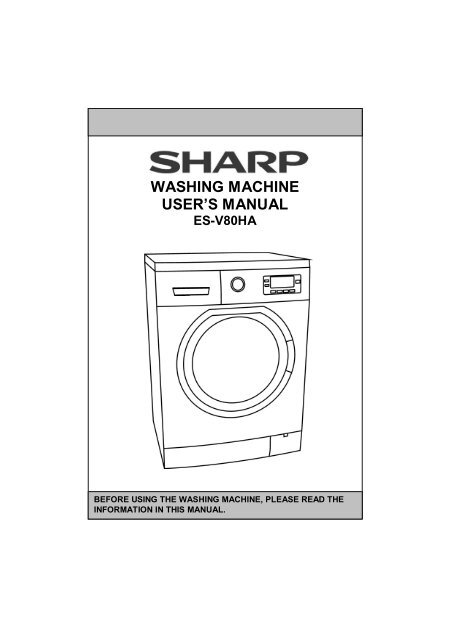

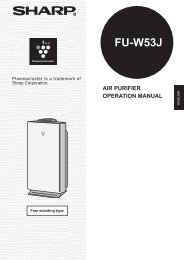

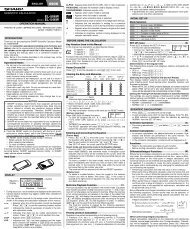
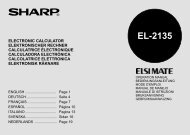
![R-291Z(ST) [Cover].indd - Sharp Australia Support](https://img.yumpu.com/19344699/1/184x260/r-291zst-coverindd-sharp-australia-support.jpg?quality=85)
